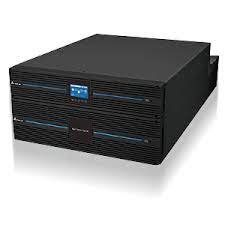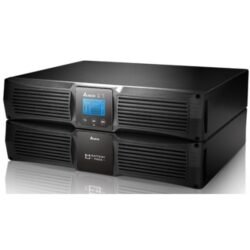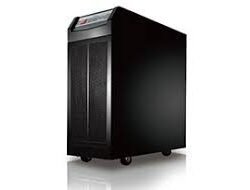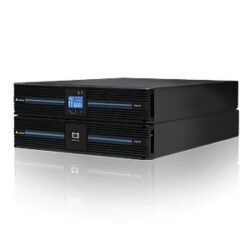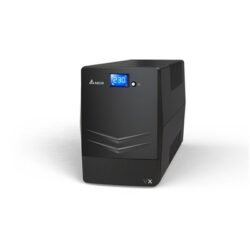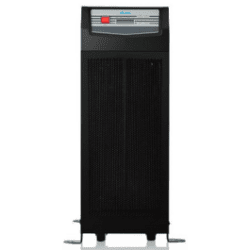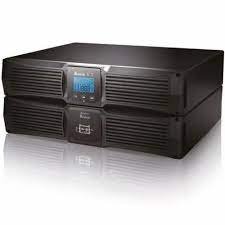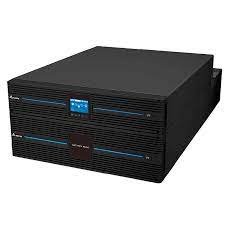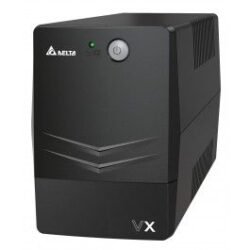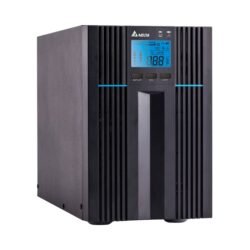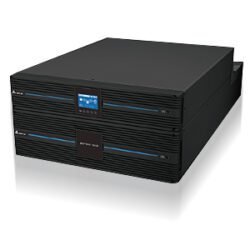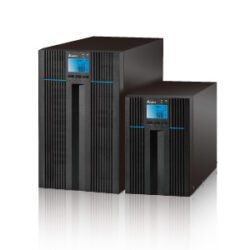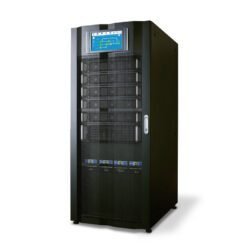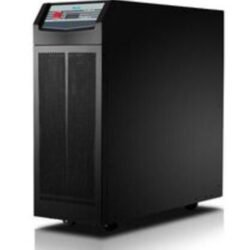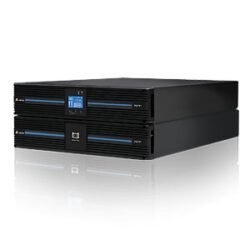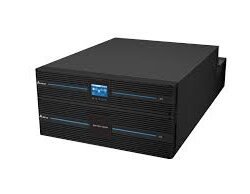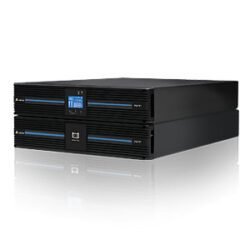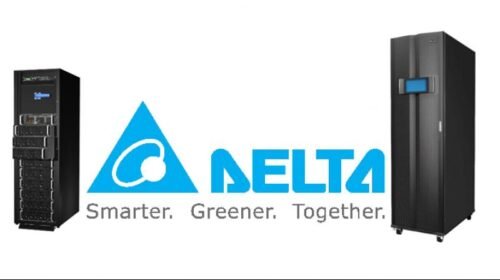
The Delta UPS business has more than a decade in designing, manufacturing and marketing UPSs globally. Delta is committed to innovating technically superior products and providing energy efficient solutions for a wide range of home, office, data center and industrial applications
Delta provides comprehensive power protection solutions for mission-critical applications. Our UPS portfolios include both standalone and modular design, Single-phase and Three-Phase configuration, and up to megawatt power capacity. With best-in-class efficiency and redundancy design, Delta’s UPS allows the greatest level of availability, scalability, and resiliency to guarantee always-on protection to mission-critical businesses
-
RT 6kVA S w -16x7Ah batt. & PDB Uninterruptible Power Supply (UPS602R2RT0B035) KSh 310,000.00 Ex-VAT Add to cartCompare
-
RT 2kVA, 230V, 2A charger, inbuilt 4*battery with UK power cord Online KSh 100,000.00 Ex-VATCompareAdd to cart
- Power Output: 2kVA (2000 VA)
- Input Voltage: 230V AC
- Input Frequency: 50/60 Hz
- Output Current: 2A
- Battery Type: Inbuilt 4 x Rechargeable Batteries
- UK Power Cord: Included
- Charging Efficiency: ≥ 90%
- Charging Protections: Overload, Short Circuit, Overcharge
- Display: LCD/LED Display for Battery Status and Charging Information
- Certification: CE, RoHS, FCC
-
RT 1kVA, 230V, 1.5A charger, inbuilt 2*battery with UK power cord. Online KSh 150,000.00 Ex-VAT Add to cartCompare
-
VX 1000VA (UK plug) Line Interactive Power Cord Delta UPS KSh 16,800.00 Ex-VATCompareAdd to cart
- 1Ph Line Interactive UPS VX Series 1000VA
- 600W
- USB
- LCD Display
- 2 Batteries (2×12/7Ah)
- Cold Start
- I=170~280V O=230V
- 50/60HZ
-
Delta EH 15KVA 240V Online UPS 3 Phase In 1 Phase Out (No Battery) KSh 535,000.00 Ex-VAT Add to cartCompare
-
RT 1kVA, 230V, 1.5A charger, inbuilt 2*battery with UK power cord Online KSh 66,000.00 Ex-VAT Add to cartCompare
-
HPH 80KVA,NO BATTERIES,I-O=220-380V Y WB (4 breakers model) KSh 1,448,000.00 Ex-VATCompareAdd to cart
- Capacity: 80KVA (Kilovolt-Ampere)
- Battery Configuration: No batteries included
- Input Voltage: 220V AC (Single-phase) / 380V AC (Three-phase)
- Output Voltage: 220V AC (Single-phase) / 380V AC (Three-phase)
- Breaker Model: 4 breakers model (for circuit protection)
- Topology: Uninterruptible Power Supply (UPS)
- Waveform: Sinusoidal
-
RT 3kVA, 230V, 2A charger, inbuilt 6*battery with UK power cord Online KSh 120,000.00 Ex-VATCompareAdd to cart
- Power Output: 3kVA (3000 VA)
- Input Voltage: 230V AC
- Input Frequency: 50/60 Hz
- Output Current: 2A
- Battery Type: Inbuilt 6 x Rechargeable Batteries
- UK Power Cord: Included
- Charging Efficiency: ≥ 90%
- Charging Protections: Overload, Short Circuit, Overcharge
- Certification: CE, RoHS, FCC
Types of Delta UPS
Delta’s UPS product portfolio includes one- and three-phase UPSs as well as online and line-interactive systems. The full product range comes in four models based on load type:
UPS Modulon family
The Modulon family features a three-phase modularization architecture for power rating requirements above 15 kVA and supports datacenters, mid-large network equipment, data storage centers and financial disaster recovery centers. The Modulon Family’s core feature is its modular design and scalability. This permits a modest initial investment in UPS systems based on current needs, which lowers the total cost of ownership, maximizes efficiency and makes it easy to grow as demand increases.
UPS Ultron family
The Ultron family are three-phase UPS systems for power rating requirements above 20 kVA that support mission critical applications including industrial equipment, datacenters, traffic control facilities, broadcast stations and backbone networks. The Ultron Family offers ultimate performance and can be relied upon for a wide range of application needs. Ultron’s rock-solid stability provides ongoing critical power supply protection and resultant peace of mind.
UPS Amplon family
The Amplon family are single phase UPS systems for power rating requirements above 1 kVA that support medium to small network devices, medical devices, security and surveillance systems, ATM and POS systems. These UPSs save space while maximizing cost benefits. The Amplon Family offers ideal power management solutions for a wide variety of SMB.
UPS Agilon family
The Agilon family are single phase UPS systems for power rating requirements under 1.5 kVA, that can support PC products, peripherals and small POS systems. UPSs in the Agilon family accept a broad range of voltage input while employing automatic voltage regulation (AVR), thereby efficiently managing the use of power for residential users and small businesses.
Main Components of a UPS
Following are the four main components in any online double conversion uninterruptible power supply (UPS) system:
· Rectifier
· Batteries
· Inverter
· Static bypass switch
UPS Rectifier
The UPS rectifier carries out several key functions. The first is to convert the input power from AC (Alternating Current) to DC (Direct Current). Its second main role is to recharge the batteries, while the DC power routes to the inverter too.
Depending on the size of the UPS, the rectifier module may incorporate the battery charger. With smaller uninterruptible power supply systems (i.e., below 3 kVA) it is not uncommon for the rectifier and battery charger to be separate components.
UPS rectifiers can accept wide input voltage fluctuations, meaning the system can handle overloads or surges without having to engage the batteries.
The batteries in a UPS system provide emergency power when the mains supply fails. Either the rectifier or a separate charger ensures that the batteries are always charged.
UPS battery systems have at least one string of batteries, with the number of batteries required depending on the DC voltage of the UPS. Batteries within a string are connected in series, so if a single battery fails, so too does the entire string.
For smaller UPS systems, the batteries are often internal to the unit. Whereas in larger solutions, UPS batteries are often housed in their own standalone cabinets.
UPS Inverter
This component fulfils the second half of the double conversion by switching the DC voltage from the rectifier or battery back to an AC output that powers the critical load.
This conversion process (AC to DC to AC) and filtering smooths out events such as spikes, sags, surges, and electrical noise, ensuring the final output is a pure sine waveform.
Static Bypass Switch
This component is a safeguard in case there’s a failure within the UPS system. In the event of a UPS fault, the static bypass switch automatically connects the load to the mains supply, bypassing the rectifier, batteries, and inverter.
Having to transfer to mains supply isn’t ideal as the power won’t be filtered or conditioned as is usually the case with an online double-conversion UPS, but it does enable equipment to continue functioning while the UPS is repaired or replaced.

